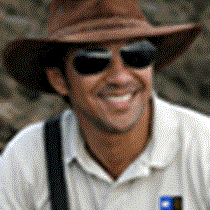Lighthouse Reef
We are finally here, Lighthouse Reef, an uninhabited offshore atoll 50 miles southeast of Belize City. It is best known to most of its visitors as the site of Half Moon Caye National Monument. Established in 1982 as Belize’s first nature reserve, the monument protects a large nesting colony of red-footed boobies along with several other rare species of seabirds. The large colony of red-footed boobies is one of only two in the Caribbean (the other is on Tobago Island off Venezuela).
After landing on the island, our guests, in small groups, walked to a platform which juts above the treetops and is used as an observatory, to see the red-footed booby and magnificent frigatebird colony. The Belize Audubon Society, caretaker of the 45-acre sanctuary, has recorded 98 bird species on Half Moon Caye, including the osprey, white-crowned pigeon and mangrove warbler.
The pleasant walk included sightings of reptile species such as the Ctenosaur, a gray dragon-like iguana that likes sleeping in tree-holes, and the elusive anole, a medium-sized lizard found in leafy-grassy areas. The always-majestic osprey was also a highlight, which also nests on the island. The island was flourishing with wildlife today and, fortunately, every one of us got his or her share of nature.
The underwater area immediately surrounding Half Moon Caye is also protected and is full of marine life. Some of us decided that the temperature had built up enough, so we armed ourselves with snorkels and fins and jumped in the water. The reward was just a few feet away from shore: beautiful patches of coral reef everywhere hiding the wildest marine biodiversity. We explored along those marine ecosystems for as long as we wanted, trying to assimilate colors, shapes and forms of corals and the species living within them. Larger creatures could be spotted such as nurse sharks and barracuda. One of our staff members, Dr Bill Bushing was among the lucky people who got to see both a hawksbill and a loggerhead turtle and even luckier to get a good underwater footage to share with us at recap.
I had always thought the Caribbean was a place to dream about, but what I never thought about was that dreams and reality could be so close and that they would merge in a place called Belize.
We are finally here, Lighthouse Reef, an uninhabited offshore atoll 50 miles southeast of Belize City. It is best known to most of its visitors as the site of Half Moon Caye National Monument. Established in 1982 as Belize’s first nature reserve, the monument protects a large nesting colony of red-footed boobies along with several other rare species of seabirds. The large colony of red-footed boobies is one of only two in the Caribbean (the other is on Tobago Island off Venezuela).
After landing on the island, our guests, in small groups, walked to a platform which juts above the treetops and is used as an observatory, to see the red-footed booby and magnificent frigatebird colony. The Belize Audubon Society, caretaker of the 45-acre sanctuary, has recorded 98 bird species on Half Moon Caye, including the osprey, white-crowned pigeon and mangrove warbler.
The pleasant walk included sightings of reptile species such as the Ctenosaur, a gray dragon-like iguana that likes sleeping in tree-holes, and the elusive anole, a medium-sized lizard found in leafy-grassy areas. The always-majestic osprey was also a highlight, which also nests on the island. The island was flourishing with wildlife today and, fortunately, every one of us got his or her share of nature.
The underwater area immediately surrounding Half Moon Caye is also protected and is full of marine life. Some of us decided that the temperature had built up enough, so we armed ourselves with snorkels and fins and jumped in the water. The reward was just a few feet away from shore: beautiful patches of coral reef everywhere hiding the wildest marine biodiversity. We explored along those marine ecosystems for as long as we wanted, trying to assimilate colors, shapes and forms of corals and the species living within them. Larger creatures could be spotted such as nurse sharks and barracuda. One of our staff members, Dr Bill Bushing was among the lucky people who got to see both a hawksbill and a loggerhead turtle and even luckier to get a good underwater footage to share with us at recap.
I had always thought the Caribbean was a place to dream about, but what I never thought about was that dreams and reality could be so close and that they would merge in a place called Belize.




